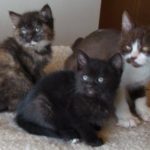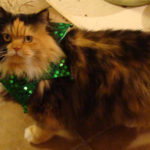History
 The Manx breed originated on the Isle of Man off the coast of Britain and the main physical characteristic of taillessness is the result of a genetic mutation that was then intensified by the cats’ remote location. Whether a tailless cat was born there or arrived on a ship and then spread its genes throughout the island cat population is unknown. The island became known for tailless cats, and that is how the breed got its name of Manx.
The Manx breed originated on the Isle of Man off the coast of Britain and the main physical characteristic of taillessness is the result of a genetic mutation that was then intensified by the cats’ remote location. Whether a tailless cat was born there or arrived on a ship and then spread its genes throughout the island cat population is unknown. The island became known for tailless cats, and that is how the breed got its name of Manx.
It is believed that Manx cats came from dedicated mousers and are still prized for their superb hunting skills often taking down prey larger than themselves. We had one small female who cornered a fox and terrorized the poor thing until we called her off.
Personality

Manx cats love people. Unlike the stereo-typical feline, you will never need to go hunting up your Manx as it will be underfoot or at most curled up within sight keeping watch over your movements. Our Manx like to lay under our computer chairs making it necessary to look before standing.
Part of loving their people is a desire to please. Because of this they are often easier to train to play fetch and to do tricks.
Some have reported that Manx kitties act as ‘watch-cats’ guarding their domain until they see if their human is ok with the “danger” when they will settle down and accept the situation.
All of these characteristics have earned the Max breed the nickname of ‘little dogs in cats clothing”.
Tail Length
Although tail length variety is not the sole characteristic feature of the breed, the chief defining one of the Manx cat is its absence of a tail. However they may also have long tail or tail of any length between the two extremes. This is caused by a naturally occurring mutation of the spine caused by a dominant gene.

Manx cats’ tails are classified according to proportional tail length as kittens (the proportion does not change after birth):
- Rumpy(rumpie) or dimple rumpy– having no tail at all, though often a tuft of hair where the tail would have grown from the rump
- Riseror rumpy riser– having a bump of cartilage under the fur, most noticeable when the animal is happy and raising its tail end
- Stumpy(stumpie) – having a partial tail of vestigial, fused vertebrae, up to about 3 cm (1 in) long
- Stubby(stubbie), shorty, or short-tailed– having a short tail of non-fused bones, up to about half an average cat tail
- Longy(longie), tailed, or taily(tailie) – having a half- to normal-length tail.

Coat Length
As with the tail the fur of a Manx can be of any length although the most common is the short sleek hair. Long haired Manx are known as Cymric.
Recently some registries or Fancys have started acknowledging two new classifications. One is the Isle of Man Shorthair (tailed) which is a short haired cat with a long tail of known Manx decent. The other is the Isle of Man Longhair (tailed). This later is a long tailed Cymric Manx.
Manx Syndrome
Health issues unique to Manx cats results when the tailless gene shortens the spine too much. The most commonly seen symptom is bowel, bladder and digestion issues. Although there can also be weakness in the rear which is when you will see the “characteristic bunny hop gate”.
Such problems can be minimized by avoiding breeding Rumpie to Rumpie. Also, the shorter the tail the longer the kitten should stay with the breeder up to 4 months of age to insure the kitten is not going to develop intestinal issues once it is fully on solid food.
